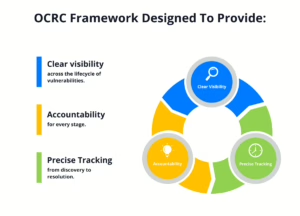Nov 21, 2024 Information hub
Vulnerability Tracking Using OCRC: A Structured Framework for Effective Penetration Testing
Vulnerability tracking is a cornerstone of robust security management. Identifying, documenting, and mitigating weaknesses across an organization’s digital assets requires precision and consistency. To address this need, Securityium uses the OCRC framework (Open, Confirmed, Resolved, and Closed) — a unique methodology that simplifies and optimizes vulnerability tracking during penetration tests.
This article dives into the origins, relevance, methodology, and benefits of OCRC, offering a practical guide for implementing it effectively.
Origins and Rationale for OCRC
In traditional security operations, vulnerability tracking was often fragmented—relying on spreadsheets, emails, or disjointed tools. This approach led to inefficiencies, missed vulnerabilities, and an overall lack of accountability.
Recognizing these challenges, Securityium uses OCRC, a streamlined, scalable framework designed to provide:
- Clear visibility across the lifecycle of vulnerabilities.
- Accountability for every stage.
- Precise tracking from discovery to resolution.
OCRC was born from the need to manage vulnerabilities effectively, particularly in large-scale projects where clarity and consistency are critical.
Why OCRC Matters in Penetration Testing
Penetration testing is a high-stakes exercise where oversight is critical to ensure no vulnerability is overlooked. OCRC addresses key challenges in vulnerability tracking:
- Accountability and Transparency: Each stage of OCRC provides clear definitions and ensures roles are assigned for better ownership.
- Real-Time Tracking: OCRC offers a dynamic system to stay updated on vulnerabilities, enabling proactive threat responses.
- Scalability: Ideal for organizations with complex IT environments, OCRC seamlessly handles high volumes of vulnerabilities.
- Built-In Quality Assurance: By incorporating validation at every stage, OCRC minimizes false positives and improves accuracy.
OCRC Methodology: A Step-by-Step Breakdown
OCRC stands for Open, Confirmed, Resolved, and Closed—each stage representing a crucial phase in vulnerability management. Let’s explore these in detail:
1. Open Stage
- Purpose: Document and log newly identified vulnerabilities.
- Sub-Stages:
- Open: Reported: The testing team discovers and documents a vulnerability, including its details, risk level, and evidence.
- Open: Unresolved: Previously mitigated vulnerabilities reverted to this state if found recurring during retests.
At this stage, all vulnerabilities are recorded in a centralized system with complete documentation for tracking.
2. Confirmed Stage
- Purpose: Validate and categorize vulnerabilities.
- Sub-Stages:
- Confirmed: Unexploited: The vulnerability is validated and poses potential risk but remains unexploited.
- Confirmed: Exploited: The vulnerability is actively exploitable and categorized by severity and impact.
This stage focuses on validation through evidence like screenshots, logs, and detailed notes. Critical vulnerabilities are flagged for immediate prioritization.
3. Resolved Stage
- Purpose: Implement and document mitigation or remediation measures.
- Sub-Stages:
- Resolved: Mitigated: Temporary measures reduce the risk while preparing for a permanent solution.
- Resolved: Remediated: A permanent fix, such as patching or configuration changes, eliminates the vulnerability.
Documentation during this stage highlights the steps taken, ensuring traceability and preparedness for final verification.
4. Closed Stage
- Purpose: Verify and formally close the vulnerability.
- Sub-Stages:
- Closed: Verified: Follow-up assessments confirm that mitigation or remediation is effective.
- Closed: Documented: All data is compiled into final reports, and the vulnerability is marked as resolved.
This stage ensures the vulnerability is completely addressed with no residual risks, providing closure and confidence in the system’s security.
Benefits of Using OCRC
- Enhanced Tracking and Accountability: Each vulnerability’s progress is meticulously tracked with defined roles, minimizing gaps in oversight.
- Streamlined Management: The structured framework reduces ad-hoc communication and operational overhead.
- Quality Assurance: Built-in QA ensures rigorous validation, reducing false positives.
- Alignment with Business Objectives: Prioritization by criticality aligns with an organization’s risk tolerance.
- Comprehensive Reporting: OCRC’s stage-specific reports are intuitive for both technical and non-technical stakeholders.
Practical Example of OCRC in Action
Imagine a penetration test identifies a critical vulnerability in a web application:
- Open: The vulnerability is documented with details such as type, severity, and potential risk.
- Confirmed: Validation confirms the issue is exploitable and categorizes it as high-severity.
- Resolved: The client applies remediation steps, such as patching or reconfiguring systems, and updates the vulnerability status.
- Closed: A retest confirms the vulnerability is resolved, and the final report includes evidence of its closure.
This process ensures clear communication, accountability, and robust security.
How OCRC Outshines Traditional Methods
Integrating OCRC into Penetration Testing
To leverage OCRC, organizations should:
- Adopt Automation: Use platforms that align with OCRC to reduce manual tasks.
- Prioritize Effectively: Focus on vulnerabilities with high criticality.
- Communicate Clearly: Provide regular updates to all stakeholders with stage-specific reports.
Final Thoughts
The OCRC framework transforms vulnerability tracking from a reactive task into a proactive, systematic process. By adopting OCRC, organizations not only enhance the effectiveness of their penetration testing but also build stronger, trust-driven relationships with stakeholders.
With cyber threats growing in complexity, structured methodologies like OCRC are indispensable tools for staying ahead in the security game. At Securityium, OCRC is more than a process—it’s a commitment to helping organizations achieve a secure digital future.
For more information or a consultation, connect with Securityium today.

